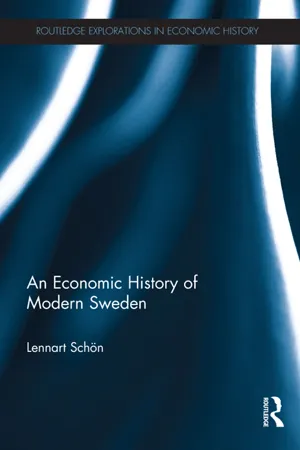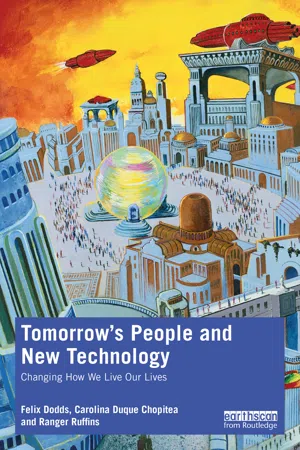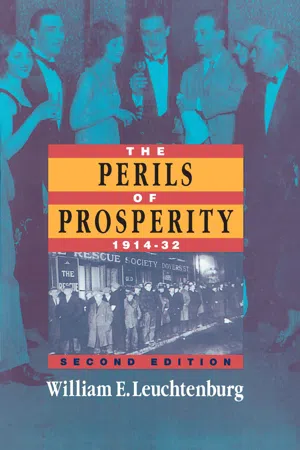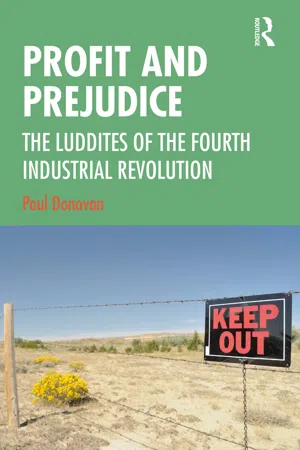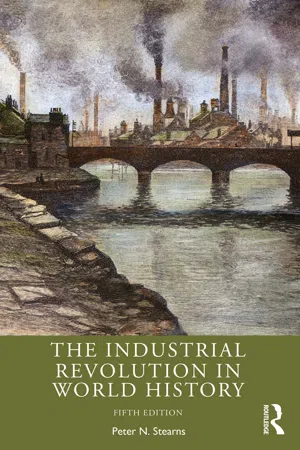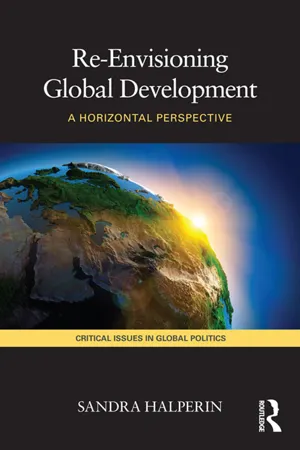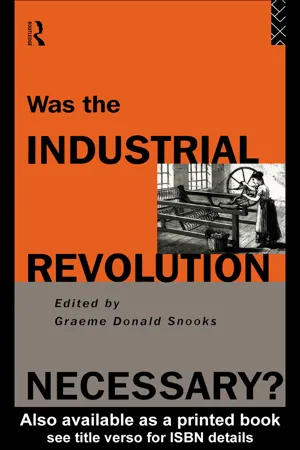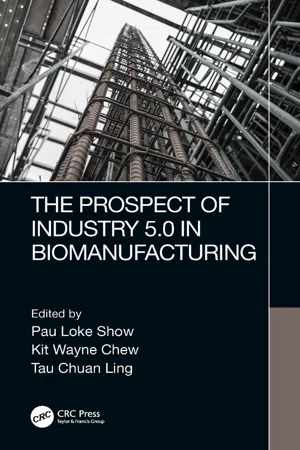History
Second Industrial Revolution
The Second Industrial Revolution was a period of rapid industrial development in the late 19th and early 20th centuries, characterized by advancements in steel production, electricity, and the widespread use of machinery. This era saw the rise of mass production, the expansion of railroads, and the development of new communication technologies, leading to significant economic and social changes.
Written by Perlego with AI-assistance
Related key terms
Related key terms
1 of 4
Related key terms
1 of 3
12 Key excerpts on "Second Industrial Revolution"
- eBook - ePub
Management, Organisations and Artificial Intelligence
Where Theory Meets Practice
- Piotr Buła, Bartosz Niedzielski(Authors)
- 2021(Publication Date)
- Routledge(Publisher)
3 steam locomotive. The first of these inventions contributed to a significant reduction in the cost of fuel in metallurgical furnaces, while the second enabled the transportation of cargo across substantial distances in less time. In consequence, civilizational development at the onset of the 19th century became even more dynamic. To a significant extent, which is worth emphasizing, it was a result of efforts of talented engineers, chemists, physicists or technologists, rather than an accident or a gift from the gods.The term “industrial revolution” was used again in 1936 by the French sociologist and psychologist Georges Friedmann to describe the changes that were taking place in Europe and in the United States during the first half of the 19th century, related to the effects of mass production, which utilized assembly lines, division of labor, development of the human being and that of entire societies.4 It is commonly accepted in literature that the Second Industrial Revolution (Industrial Revolution 2.0) falls in the period 1870–1914. This means that, after one hundred years from the beginning of the First Industrial Revolution, the world and humanity had to face another one, this time characterized by even greater upgrades and challenges. The greatest innovations connected with the Second Industrial Revolution era, which strongly affected the dynamics of industrial development at that time, were directly linked to two new energy sources: electricity (electric motor) and oil and natural gas (internal combustion engine). With them, the industrial world witnessed a sudden transition from conventional production methods to more innovative ones, based on new technologies, which changed the earlier processes of manufacturing and processing goods that took place in the majority of British and US factories. However, the changes, important from the point of view of technology and innovation, were taking place not only in industry, but also in communications or transportation. In the case of communications a considerable role for human development and the world was played initially by the telegraph,5 which revolutionized communication systems and allowed people to communicate remotely and then by the telephone,6 the forefather of the smartphone, which is now considered the foundation of contemporary communication systems. In transportation, groundbreaking for that era and later also the world’s further history, were discoveries by US aviation pioneers, the Wright brothers.7 - eBook - ePub
- Lennart Schön(Author)
- 2012(Publication Date)
- Routledge(Publisher)
The two points of view complement each other to a certain extent, and it is easy to find examples of each. But as generalisations of the main vectors of growth, they are distinct and competing. While the human capital thesis stresses that demand for knowledge generally increased and that everyone obtained a greater return on long-term investment in education, the degradation thesis stresses that knowledge came to be separated from workers and concentrated among engineers and researchers in the business organisation. As a generalisation of twentieth century trends, Braverman’s thesis falls short, given that demands for knowledge and education undeniably increased in all areas. But the thesis is valid in the more limited sense that rapid restructuring rendered much of previous knowledge obsolete, replacing it with both more sophisticated skills in new areas and simplified procedures in old areas.Industrial transformation
The First Industrial Revolution was a breakthrough for the factory system and brought with it growing markets and deregulation of economic policy. But it was largely dependent on agricultural trends for both demand and access to input products. Similarly, agriculture and the rural areas had continued to shape social and political conditions. However, the Second Industrial Resolution was a breakthrough for industrial society. Industry began to set the direction of social development, more clearly. The change was most pronounced in countries that industrialised fairly late in the nineteenth century and therefore underwent a rapid transition from agrarian to industrial society.The Second Industrial Revolution made towns the emblem of the new society. The emergence of industrial towns was supported by the fresh opportunities for mass production of goods that emerged in the late nineteenth century. Expanded railway networks and faster ships made it easier to distribute growing volumes of goods over long distances, allowing greater centralisation of production. New, more flexible systems of energy supply also contributed to the process. Access to raw materials and energy had less of an impact on the location of production facilities, while the importance of proximity to markets and skills increased. Concentration in growing cities and a rising standard of living created expanding markets for industrial goods. Growth of industrial towns was supported by the emergence of complementarity between technical advances in production and expansion of the market. - eBook - ePub
Tomorrow's People and New Technology
Changing How We Live Our Lives
- Felix Dodds, Carolina Duque Chopitea, Ranger Ruffins(Authors)
- 2021(Publication Date)
- Routledge(Publisher)
Increasing discontent with the inhumane working conditions and living standards powered the trade union movement. Workers were paid very low wages and worked long hours in factories with little or no safety standards. Trade unions (labour unions in the US) were created first in 1824, when they coalesced around demands for better wages and working conditions. Out of these first campaigns, child labour laws were born, and regulations about health and safety at work began to address some of the negative new circumstances that industrialisation was having on the lives of the working class. Just as the Luddites did, the union movement also fostered violent uprisings. Nevertheless, modern working standards, including minimum wage, overtime pay, health benefit plans, eight-hour workdays, and weekends off were shaped by union insistence on collective bargaining.The Second Industrial Revolution: The age of science and mass production
Despite the great advances that came with the First Industrial Revolution, the world was still quite different from what it is today; there was no electricity, no cars, and no telephones, yet the First Revolution was the foundation for the Second. Approximately 40 years after the disruption brought by the Industrial Revolution, in the 1870s, a second period of change was brewing.The Second Industrial Revolution, also known as the Technological Revolution, was characterised by a period of rapid standardisation and industrialisation between the late 19th century and early 20th centuries. Underpinning this was the rapid expansion of railroads and telegraph lines after the 1870s that allowed for unprecedented movement of people and ideas, until movement was interrupted in 1914 by World War I.This was also a period of growth in the populations of cities and an expansion of factories as workplaces for more and more people. There were significant advances in the creation of steel and chemicals, as science began to be applied in manufacturing processes. Most importantly, this revolution gave us petroleum, the energy source that is crucial for modern human life as we know it. - eBook - ePub
- William E. Leuchtenburg(Author)
- 2010(Publication Date)
- University of Chicago Press(Publisher)
10The Second Industrial Revolution
In the late eighteenth and early nineteenth centuries the industrialization of England accelerated at such a pace that historians have found no term adequate to describe it save one usually reserved for violent political change—revolution. In the late nineteenth century and early twentieth century the productive capacity of the American economy increased at a rate greater than that of the Industrial Revolution. After World War I, the United States, benefiting from half a century of industrial progress, achieved the highest standard of living any people had ever known, though one that still left many millions in poverty. National income soared from $480 per capita in 1900 to $681 in 1929. Workers were paid the highest wages of any time in the history of the country; essentially unchanged from 1890 to 1918, the real earnings of workers—what their income actually would buy at the store—shot up 22 per cent in just seven years. At the same time, the number of hours of work was cut: in 1923, United States Steel abandoned the twelve-hour day and put its Gary plant on an eight-hour shift; in 1926, Henry Ford instituted the five-day week, while International Harvester announced the electrifying innovation of a two-week annual vacation with pay for its employees.In 1922 the country, already fabulously productive by comparison with other nations, started a recovery from the postwar depression that continued, with slight interruptions, until the fall of 1929. The key to the piping prosperity of the decade was the enormous increase in efficiency of production, in part the result of the application of Frederick W Taylor’s theory of scientific management, in part the outgrowth of technological innovations. In 1914, at his Highland Park plant, Henry Ford had revolutionized production by installing the first moving assembly line with an endless-chain conveyor; three months later, his men assembled an automobile, down to its smallest parts, in 93 minutes. A year before, it had taken 14 hours. During this same period, machine power replaced human labor at a startling rate: in 1914, 30 percent of industry was electrified, in 1929, 70 percent. The electric motor made the steam engine obsolete; between 1919 and 1927 more than 44 percent of the steam engines in the United States went to the scrap heap. Since labor came out of the postwar depression with higher real wages—employers feared a new strike wave if they cut wages as sharply as prices fell—business was stimulated to lower production costs. With more efficient management, greater mechanization, intensive research, and ingenious sales methods, industrial production almost doubled during the decade, soaring from an index figure of 58 in the depression year of 1921 to 110 in 1929 (1933–39 = 100). This impressive increase in productivity was achieved without any expansion of the labor force; manufacturing employed precisely the same number in 1929 as in 1919. The summit of technological achievement was reached on October 31, 1925, when Ford rolled a completed automobile off his assembly line every ten seconds. - eBook - ePub
Profit and Prejudice
The Luddites of the Fourth Industrial Revolution
- Paul Donovan(Author)
- 2020(Publication Date)
- Routledge(Publisher)
The past three industrial revolutions can be simplified as (1) steam power, (2) electric power and (3) computer power. This is, clearly, a significant oversimplification of the complex changes of each revolution, but we have to start somewhere. The first industrial revolution was mainly about steam power and began in the mid- to late 1700s in the UK. It brought with it the expansion of the factory system. There was also some urbanisation and other changes. The first industrial revolution suited the UK, as its political and social structure made more of the changes than other countries, at least at first.The Second Industrial Revolution was about electricity and the assembly line. Americans often date this revolution from 1870 to the 1920s or 1930s. This revolution saw the (slow) introduction of electric power into the global economy. How factories worked started to change. Electrical machinery allowed a different way of working to steam-powered machinery. As with the first revolution, the second included faster travel and more urbanisation. Globalisation accelerated. Economic events in one country had economic, social and political consequences on the other side of the world. The Second Industrial Revolution arguably had a bigger impact on the US than anywhere else. Geography, the starting point of a still relatively primitive urban environment and limited earlier industrialisation, meant that the US was able to change more dramatically than other economies.The third industrial revolution was the microchip revolution. Computer power started to develop during the Second World War. Initially, the use of computers was generally restricted to the government, with a military focus. Famously, in 1945, British Prime Minister Sir Winston Churchill ordered that the world-class computers of the top-secret code-breaking Bletchley Park be broken up into pieces no larger than a fist.5 - eBook - ePub
- Peter N. Stearns(Author)
- 2020(Publication Date)
- Routledge(Publisher)
Part 2 The Second Phase, 1880–1950 The New International CastPassage contains an image
7 The Industrial Revolution Changes Stripes, 1880–1950
Three major developments defined the second phase of the industrial revolution in world history from the late nineteenth century to the mid-twentieth: industrialization outside the West, redefinition of the West’s own industrial economy, and growing involvement of nonindustrial parts of the world, along with an overall intensification of international impact. This phase began to take shape in the 1870s and 1880s, though no firm markers divided it from previous trends. Several Western societies, including Germany and the United States, were still actively completing their basic transformation, becoming more fully urban and committed to the factory system as their manufacturing power presented new challenges to Britain, the established industrial power. Large numbers of new workers, fresh from the countryside, still poured into German and, particularly, U.S. factories, experiencing much of the same shock of adjustment to a new work life that earlier arrivals had faced a few decades before. But even as many trends continued, the phenomenon was changing shape (see Map 7.1 ).Map 7.1 The Industrial Revolution in Europe, 1870–1914.Second-Phase Trends
In terms of long-range impact, international developments were particularly striking. Several major new players began to industrialize by the 1880s and were the first clearly non-Western societies to undergo an industrial revolution. Russia’s industrial revolution had a massive impact on global power politics. Japan’s revolution altered world diplomacy as well and ultimately had an even greater effect on the international balance of economic power. The focal point of the second phase of the industrial revolution involved the transformation of these two key nations. By 1950, when their revolutionary phases were essentially complete, neither had matched the West’s ongoing industrial strength. But a key measure of these later industrial revolutions—like those of the United States and Germany before—was the capacity of these societies to grow more rapidly than the established industrial powers. Later industrial revolutions could allow newcomers to begin to catch up, and this feature marked many aspects of world history from 1880 to the present day. - eBook - ePub
Re-Envisioning Global Development
A Horizontal Perspective
- Sandra Halperin(Author)
- 2013(Publication Date)
- Routledge(Publisher)
3 Industrialization and the expansion of capital Core and periphery redefinedThe development of capitalism, according to most accounts, involved sweeping changes, first in agriculture and then, in its second and most vital stage, in industry. The previous chapter challenged conventional assumptions about the agricultural revolution which, it is generally thought, laid the basis for England’s industrial ‘take-off’. This chapter challenges widely held assumptions about the industrial revolution.We can begin with the term ‘industrial revolution’ itself. As historians have long argued, the use of the term ‘industrial revolution’ to describe the changes that took place in Europe during the latter half of the eighteenth century is misleading (Clark 1957: 652).1 The term suggests that there occurred at that time a revolution in technology that transformed the means of production. But there was no technological revolution, no transformation in means of production during the period of what we call the ‘industrial revolution’. Large-scale mechanized manufacturing had existed, in Europe as elsewhere, for at least a century (more likely several); and while Europe at that time saw an increase in the scale of industrial production, involving a massive mobilization of human and material resources and a reorganization of production processes, this revolution of scale, as it might be called, involved neither a revolution in technology nor a transformation either of means or relations of production.What, then, is meant by the term ‘industrial revolution’? The previous chapter ended by noting that, in the eighteenth century, powerful groups in Europe had launched a broad campaign to dismantle regulations tying production and investment to local economies. As this chapter will recount, by the end of that century, these efforts had succeeded in bringing about changes designed to ‘disembed’ local economies and accelerate the globalization of capital.2 Conventional historiography would lead us to assume that these developments, along with other changes at the time, were a result of the ‘industrial revolution’. But this chapter will argue that it was precisely these changes – the disembedding of local economies and the globalization of capital – that came to be called, misleadingly, the ‘industrial revolution’. Wherever industrial production expanded, whether of manufactured or agricultural or mineral goods, it was in order to increase exports. In Britain (‘the first industrial nation’), the capture of overseas markets through military means, and the successful struggle by aristocrats and wealthy merchants to free capital from state regulation, provided opportunities for these groups to profit from increasing overseas sales. It was only then - eBook - ePub
- Graeme Snooks(Author)
- 2012(Publication Date)
- Routledge(Publisher)
1 NEW PERSPECTIVES ON THE INDUSTRIAL REVOLUTIONGraeme Donald SnooksOne of the oldest and most enduring fields of study in economic history is the Industrial Revolution. Since Arnold Toynbee first delivered his famous lectures on the subject at Oxford in the early 1880s, the Industrial Revolution has held an undiminished fascination for generations of economic historians, development economists, students, and the general public. The reason for this obsession is not hard to find—the Industrial Revolution is an event that marks the boundary between the modern period of economic growth driven by continuous technological change and earlier periods of human experience universally regarded as innocent of either rapid or sustained increases in real GDP per capita. It marked the first technological transformation—or ‘technological paradigm shift’ as I have called it elsewhere1 —since the Neolithic Revolution about 10,600 years ago. Little wonder it has attracted so much attention.But surely after a century of detailed investigation there is little more that needs to be said about this, albeit central, issue in the modern economic history of human society. Surely now the major priority—as in the latest scholarly book on the subject2 —is to survey the vast existing literature on the Industrial Revolution so as to reach a consensus about this pivotal event. Once this has been done perhaps we should redirect our attention to economic change since the Second World War when revolutionary changes of another type—the shift of married female labour from the household to the market—occurred.3 Certainly there is a need for much more work on this later period but, as I will show in this introduction, there are many more issues to be raised concerning the Industrial Revolution.We have only begun to scratch the surface of a field that needs to be ploughed long and deep. Even in areas which, at first sight, appear to be experiencing diminishing returns—such as the estimation of rates of growth and of changes in living standards—there is much fundamental work that remains to be done. We need to turn from reworking the estimates of others to constructing entirely new estimates based upon detailed new data sources as has been done recently with the new biological evidence. But even more importantly we need to view the Industrial Revolution from entirely different vantage points to those traditionally used. Indeed, the main objective of this book is to adopt a fresh approach to this well-worked field by asking new questions about: the wider role of the Industrial Revolution in human history; the contribution made by natural resources to this process; whether rapid and sustained growth is a modern invention; and what role the household played in the Industrial Revolution. New perspectives are required because many of the current interpretations can be traced back to the untested reasoning of the classical economists of the late eighteenth and early nineteenth centuries. - eBook - ePub
- Pau Loke Show, Kit Wayne Chew, Tau Chuan Ling(Authors)
- 2021(Publication Date)
- CRC Press(Publisher)
Akhter and Ormerod 2015 ).1.1.2 Industrial Revolution 2.0The Second IR is commonly known as the Technological Revolution, which is said to begin between the year of 1870 and 1914s; although number of major breakthrough events can be dated to the 1850s. However, it was seen that swift rate of pioneering inventions were dawdled after year 1825 and accelerated in the last third of the century (Mokyr 2000 ). In this revolution, the invention moved toward micro invention instead of macro invention which focused mainly on the productivity, and product quality improvements rather than path breaking invention.It was observed that the inventions after 1870s were different compared to the First IR and it was found that the innovations were more productive and denser (Mowery and Rosenberg 1991 ). One of the aspects during this revolution is that people viewed useful knowledge can be mapped into new technology. This can be further explained that during the previous IR i.e., First IR, most people are unable to understand how certain things do not function and hardly understood why it could work for certain inventions from engineering, medical technology, to agriculture (Mokyr 2000 ). Hence, the people’s viewpoint of technology is knowledge and considerable feedback from technology to science that lead to outcomes of technology improvement and novel invention during this revolution. The second aspect during this revolution is the changing nature of the organization of production (Mokyr 2000 ). This has resulted in a massive boost in the economic scale in terms of manufacturing and organizational, and marketing factors involved. A typical example in manufacturing is providing storage for chemicals, which involves the construction of storage containers which correlated to the surface area and the volume of the chemicals interrelates with the capacity of storage. As for the organizational factor, an example can be the mass production via interchangeable parts technology involved. As for the involvement of the marketing side, it was observed that big U.S. companies such as Dupont, General Electric, and others were involving a small portion of the labor force and emphasized flexibility and targeting to a more general market (Floud 2004 - eBook - ePub
The Global Economy
A Concise History
- Franco Amatori, Andrea Colli(Authors)
- 2019(Publication Date)
- Routledge(Publisher)
The second wave was a bridge between the first and Second Industrial Revolutions, in which the changes taking place were no less revolutionary, since they had a wider and more solid scientific base. 12 The three most innovative sectors of the Industrial Revolution were cotton and textiles, energy and the iron industry. In the cotton-spinning industry, the rising demand for yarn drove the design of machinery produced during the 1760s and 1770s: the jenny, the water frame, and the mule - jenny. Productivity grew at an impressive rate: in 1812 a spinner could produce as much yarn as 200 workers before invention of the jenny. Continual improvements were made to machinery throughout the period of the Industrial Revolution, including the use of iron instead of wood, and the increased number of spindles. It had taken Crompton’s 1769 mule 2,000 hours to produce 100 lbs of yarn, but Roberts’ self-acting mule reduced this 135 hours in 1825. The added value of cotton production rose from under £500,000 in 1760 to around £25 million by the mid-1820s. This sensational progress and the incredible expansion of the cotton industry explain why many have seen this as the leading sector. 13 The Industrial Revolution’s most famous invention was the steam engine. Although it was improved by James Watt between 1769 and 1787, it began to have a decisive role only after 1830 (Table 4.6), allowing the revolution to continue, ensuring that productivity grew rapidly as its use became widespread. This became possible only after further improvements and technological development, when new applications and combinations with existent techniques were found, a century after the first machine was produced - eBook - ePub
Global Sustainable Communities Handbook
Green Design Technologies and Economics
- Woodrow W. Clark II(Author)
- 2014(Publication Date)
- Butterworth-Heinemann(Publisher)
The combination of Gutenberg’s printing press, which made the quick dissemination of innovation and ideas possible, and Watt’s coal-driven steam engine, which created a whole new energy source, triggered an explosion in industrial activity. Chemical energy from coal was transferred to thermal energy and then to mechanical energy. The steam engine powered industrial machinery and steam locomotives. Suddenly, a world was created that needed people who understood engineering and combustion engines. New education, business, and employment sectors were created to support these new technologies.The First Industrial Revolution (1IR) was surging. It was a turning point in human history that started around 1760 and ran through the last part of the 19th century. Great Britain led the world as it transitioned from a manual labor, draft animal-based economy to machine-based manufacturing. Coal was the prime energy source and the United Kingdom had plenty of it. Society was altered forever, as major changes in agriculture, manufacturing, mining, warfare, transportation, philosophy, and communications took place.Watt’s engine helped usher in Britain’s great textile and manufacturing industries. It helped the British navy cement its authority and opened new commercial trade routes. Soon, all of Western civilization was entrenched in the 1IR, driven by steam, and surrounded by innovative ideas, which were distributed with the help of the printing press.The First Industrial Revolution hastened the drive toward large-scale manufacturing. At first, machines started to replace manual labor, horsepower, and wind and waterpower. This transition eventually reached North America, hastened by the westward expansion and the discovery of gold in California in 1849. American communities, which were based on trade and agriculture and dependent on tools and animals, began to rely more and more on machines and engines.The Second Industrial Revolution
America had its own version of the Enlightenment driven by the brilliant Ben Franklin. One of the original Founding Fathers of the United States, Franklin was a prolific scientist and inventor. Around 1752, he conducted the famous kite experiment in Philadelphia, and the era of electricity was ushered in by this pudgy physicist standing in a muddy field waving a kite with a key at lightening clouds. Fortunately, Franklin avoided electrocution, which was the fate of others trying to duplicate his experiment. - eBook - ePub
A World to Win
The Life and Works of Karl Marx
- Sven-Eric Liedman, Jeff Skinner(Authors)
- 2018(Publication Date)
- Verso(Publisher)
But simply calling it a revolution can make its precise meaning unclear. The images of political revolutions govern its interpretations; barricades and battle formations appear in the mind’s eye. But for the school of thought that Marx would come to leave his mark on, the process of industrialization was the most thoroughgoing – fundamental, in fact – revolution of another type.Industrialization, unlike political revolutions, does not have a birth date. It is a process that is only possible to distinguish after it has achieved a certain scale. It had its beginnings in England, Scotland, and Wales during the second half of the eighteenth century and required a long series of prerequisites, such as the expansion of sheep-breeding and wool production and the overpopulation of the countryside, as well as a series of technological innovations – especially the continuing domestication of steam power.1 The necessary infrastructure was established: first canals, and then – a few decades into the nineteenth century – railroads that were built for transport of both cargo and people.2 The villages where this production was located began to grow rapidly and cities became increasingly bloated; factories were constructed wherever there was energy to run them, and coal dominated, quickly causing environmental destruction on a previously unseen scale. But the wheels clattered faster and faster and productivity increased, creating a new kind of more expansive but also riskier wealth than the great landed properties of the aristocracy or the plunder from colonialism. Periods of brilliant economic success were replaced by crises where stock lay unsold, and many of the recently wealthy became destitute. But those who made it through the wringer came out of the crisis strengthened, with enough resources to make use of constantly new technological aids; incessant societal reorganization helped fortunate owners enjoy the fruits of increasingly efficient production.Cotton was the commodity that set industrialization going in Great Britain. Raw materials were brought from increasingly vast plantations in America, where people stolen from Africa worked under the inhumane conditions of slavery. The damp British climate turned out to be ideal for the cotton trade, and the machines required for processing were relatively cheap. The British, who had recently imported cotton fabrics from India, soon dominated the entire world market.
Index pages curate the most relevant extracts from our library of academic textbooks. They’ve been created using an in-house natural language model (NLM), each adding context and meaning to key research topics.
Explore more topic indexes
Explore more topic indexes
1 of 6
Explore more topic indexes
1 of 4

